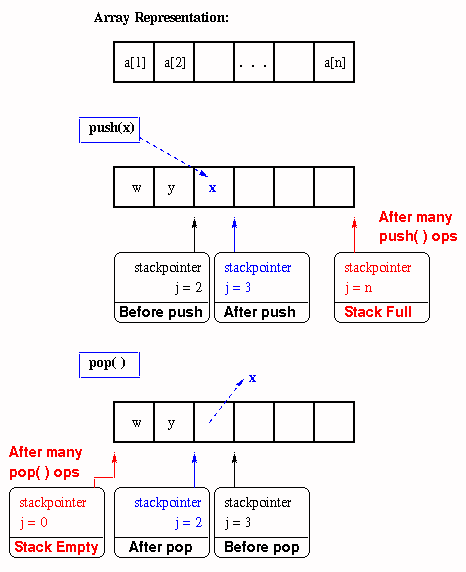Stacks
An array is a random access data
structure, where each element can be accessed directly and in constant time. A
typical illustration of random access is a book - each page of the book can be
open independently of others. Random access is critical to many algorithms, for
example binary search.
A linked list is a sequential access data
structure, where each element can be accesed only in particular order. A
typical illustration of sequential access is a roll of paper or tape - all
prior material must be unrolled in order to get to data you want.
In this note we consider a subcase of sequential
data structures, so-called limited access data sturctures.

Stacks
|
A stack is a container of objects that are
inserted and removed according to the last-in first-out (LIFO) principle. In
the pushdown stacks only two operations are allowed: push the item
into the stack, and pop the item out of the stack. A stack is a
limited access data structure - elements can be added and removed from the
stack only at the top. push adds an item to the top of the stack, pop removes
the item from the top. A helpful analogy is to think of a stack of books; you
can remove only the top book, also you can add a new book on the top.
A stack is a recursive data structure.
Here is a structural definition of a Stack:
a stack is either empty or it consistes of a top
and the rest which is a stack;
|
|
Applications
The simplest application of a stack is to reverse a
word. You push a given word to stack - letter by letter - and then pop letters
from the stack.
Another application is an "undo" mechanism
in text editors; this operation is accomplished by keeping all text changes in a
stack.
|
|
 |
Language
processing:
·
space for parameters and local variables
is created internally using a stack.
·
compiler's syntax check for matching
braces is implemented by using stack.
·
support for recursion
Implementation
In the standard library of classes, the data type
stack is an adapter class, meaning that a stack is built on top of
other data structures. The underlying structure for a stack could be an array,
a vector, an ArrayList, a linked list, or any other collection. Regardless of
the type of the underlying data structure, a Stack must implement the same
functionality. This is achieved by providing a unique interface:
public interface StackInterface
{
public void
push(AnyType e);
public
AnyType pop();
public
AnyType peek();
public
boolean isEmpty();
}
The following picture demonstrates the idea of
implementation by composition.

Another implementation requirement (in addition to
the above interface) is that all stack operations must run in constant
time O(1). Constant time means that there is some constant k such that an
operation takes k nanoseconds of computational time regardless of the stack
size.
Array-based
implementation
|
|
In an array-based implementation we maintain the
following fields: an array A of a default size (≥ 1), the variable top that
refers to the top element in the stack and the capacity that refers
to the array size. The variable top changes from -1 to capacity
- 1. We say that a stack is empty when top = -1, and the stack is full
when top = capacity-1.

In a fixed-size stack abstraction, the capacity
stays unchanged, therefore when top reaches capacity, the
stack object throws an exception. In a dynamic stack abstraction when top reaches capacity,
we double up the stack size.
|
Linked
List-based implementation
|
Linked List-based implementation provides the best
(from the efficiency point of view) dynamic stack implementation.
 |
|
No comments:
Post a Comment